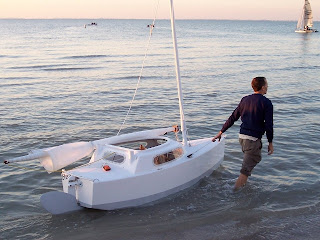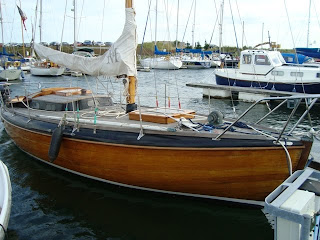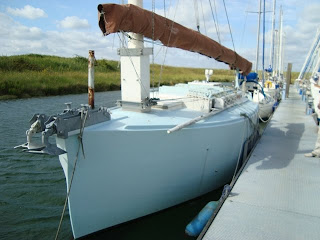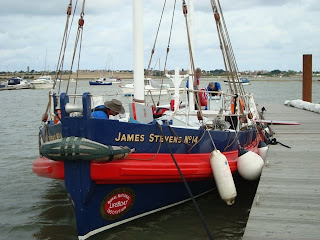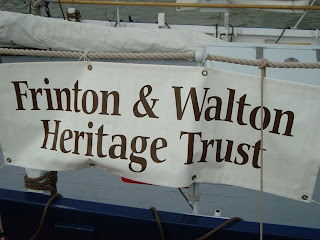
'Souriceau'

Accommodation Drawings
I am always on the lookout for new boats, and a friend has asked me to tell him what I think about a new French style, micro-cruiser. She is a little, two man yacht with a lifting keel and twin rudders, that looks a bit like a Mini Transat 6.5 racing yacht, but smaller. Thanks to the efforts of her designer, Eric Henseval, a fair amount of information about his 'Souriceau' is available online.
Here are some of her stats:
Hull length: 4.75 m
Beam: 2.20 m
Draught max: 1.35 m
Draught min: 0.57 m
Retractable bulb keel
2 Berths
Galley and Chart Table
Twin Tillers inside; single outside
Twin Rudders
Displacement: 530 kg
Ballast Keel : 120kg
Sail Area : 18 m2
Unsinkable
Hull – GRP sheathed plywood
My observations can only be based on the info I’ve been able to obtain from the Internet. My first thought was that she would be a comparatively expensive boat to build, because of her numerous fittings, and in this respect I questioned the need for two domes and two rudders. Further examination revealed that when ‘Souriceau’ dries out on a flat surface, she settles upright on the bulb of her retracted keel and the tips of her splayed rudders. Without twin rudders she would flop over on her side. However, I would be concerned that her rudders may become damaged, during the settling process. Likewise, I would be equally worried for the rudders when the boat starts to lift on a rising tide. I would be very anxious if there were rocks or small boulders in the vicinity.
I questioned the need for a cockpit, since it reduces her interior space, and gives little protection or security for her crew. I noted that she has single chainplates for her double shrouds, and she does not have a backstay, which, for an ocean-going vessel, may be an oversight. Optional running backstays would minimize the risk of rigging failure, and if her owner wanted to sail her across an ocean, he may consider adding a second forestay, not just for making the rig more secure, but for setting twin foresails.
I think she would perform well at sea when the wind is less than Force 7, but her dart-shaped hull may make her vulnerable when running down the face of steep waves, because her very pointed bow has little internal volume for lifting her foredeck clear of the troughs. If she where to bury her bow, she could be pitchpolled.
I am not by nature a negative person, but with this boat, from the little I know of her, I would have reservations about building her for my own use, and I certainly would not be able to afford a professionally produced one. The blurb on the Web suggests she could be built for 8,000 euros, yet I spent almost as much building my 13’ 10” Paradox, which did not have expensive metal spars, domes, hatches, twin rudders and a ballasted lifting keel; neither did she have semi-hi-tech sails ………… and don’t forget to include the cost of a road trailer, if she is to be transported overland.
Please bear in mind that what I’ve stated here is my personal interpretation of information I’ve gleaned from the Internet. You may have your own quite different views. I would like you to know that I have no axe to grind. I am simply trying to be objective while answering my friend’s query, and at the same time share my thoughts with readers of this Blog.
Links
Souriceau au Debride
http://www.youtube.com/watch?v=RPJUaYmN3SE&feature=player_embedded
Navigation vue de l'interieur de Souriceau
http://www.youtube.com/watch?v=rMdoMbPTB-4&feature=player_embedded
Accommodation Drawings
http://u.jimdo.com/www15/o/s73b0deaf5e3196ec/img/i6bd5c1c0699edd02/1279217168/std/image.jpg
Photo – Dried out, on drop keel and rudders
http://u.jimdo.com/www15/o/s73b0deaf5e3196ec/img/id84aa8caef32128d/1279217168/std/image.jpg
Photo – Sailing
http://u.jimdo.com/www15/o/s73b0deaf5e3196ec/img/i53735e0ae8117f1d/1279217168/std/image.jpg
Photo – looking towards the bow from the cockpit
http://u.jimdo.com/www15/o/s73b0deaf5e3196ec/img/i884fa71ccde066b6/1279310465/std/souriceau-4-75m-micro-cruiser.jpg
Duckworks Photos
http://www.duckworksmagazine.com/09/splash/apr/index.htm
Plans from Duckworks $730
http://www.duckworksbbs.com/plans/henseval/soriceau/index.htm













